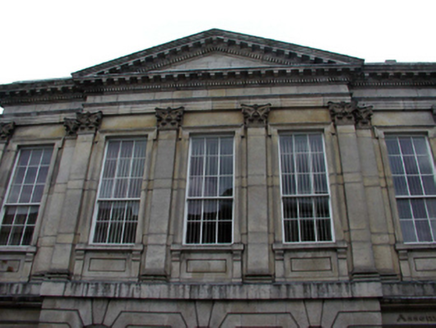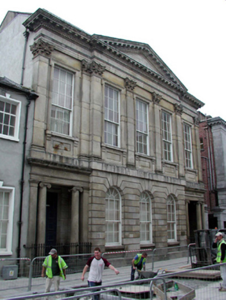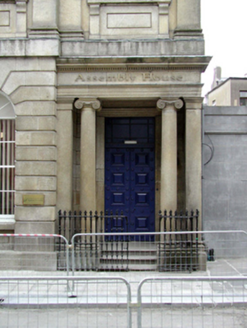Survey Data
Reg No
22501065
Rating
National
Categories of Special Interest
Architectural, Artistic
Previous Name
Waterford Savings Bank
Original Use
Bank/financial institution
In Use As
Office
Date
1840 - 1845
Coordinates
260533, 112576
Date Recorded
17/06/2003
Date Updated
--/--/--
Description
Terraced five-bay two-storey Classical-style bank, built 1841, retaining original aspect with three-bay two-storey pedimented breakfront. Now in use as offices. Pitched slate roof (gabled to breakfront) with clay ridge tiles, and cast-iron rainwater goods. Granite ashlar wall to front (south-west) elevation with channelling to ground floor, plain stringcourse to first floor, Corinthian pilaster strips to first floor with entablature, and plain frieze over having modillioned moulded cornice and modillioned tympanum to pediment. Unpainted rendered walls to remainder. Round-headed window openings to ground floor with cut-stone sills. 6/6 timber sash windows with fanlights. Square-headed window openings to first floor with cut-stone consoled sills on inscribed panels, and lugged architraves. 9/6 timber sash windows. Square-headed door openings approached by flight of three cut-limestone steps with cut-granite Ionic in antis doorcases having cut-stone pilasters, entablatures, friezes and moulded cornices, and timber panelled double doors. Road fronted with concrete footpath to front and sections of cast-iron railings to entrance bays having Fleur-de-Lys finials.
Appraisal
This bank, which has been very well maintained despite a subsequent change of use, is an imposing substantial composition in a decorative Classical style. The bank, designed by Thomas Jackson (1807 - 1890), is composed of balanced proportions and is a prominent feature in the streetscape of O’Connell Street. The bank retains many important early or original salient features and materials to the exterior, and it is assumed that the interior is similarly intact, incorporating early schemes of importance. The bank is distinguished by the fine cut-stone detailing throughout, which enhances the architectural and design qualities of the composition, and which attests to high quality stone masonry. The bank is also of significance, representing the continued prosperity of the locality in the mid nineteenth century.





